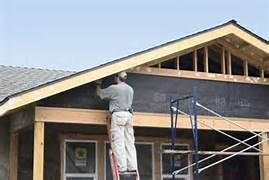Often times, when you buy a home, it’s not perfect. Fortunately, the magic of remodeling allows you to craft your current residence or a prospective property into your dream home. However, unless you’re flush with cash, you won’t be able to pay for your renovation project out of pocket. When faced with this dilemma, there are several ways for you to go about getting the funds.
Remodeling a Purchase
FHA 203k mortgages
The FHA 203k loan is backed by the Federal Government and is solely for the purpose of helping those who wish to purchase and renovate a home. There are two different kinds of 203k loans, each geared toward different types of projects.
1. Standard 203k
The standard 203k is for all projects that require professional architectural drawings and inspections. Typically, if the property has any sort of structural damage, or any other problems that make it unlivable, the Standard 203k is the way to go. There is a minimum cost of $5,000, and the project must be completed in six months, although a lender can approve extensions.
2. Streamlined 203k
The streamlined 203k is for less complicated projects that do not require the help of a consultant, architect, engineer, or that will not exceed $35,000. Due to the simpler scope of the task, the loan process is straightforward and will allow you to finish the project in a timely manner.
For both types of 203k loans, the properties will have to meet FHA requirements, including a maximum home value. Fortunately, the FHA’s guidelines are more lenient than those of conventional loans – including more flexible credit, income, and appraisal requirements.
Energy Improvement Mortgages (EIMs)
If you are planning to make renovations that increase energy-efficiency, the energy improvement mortgage is the way to go. An EIM allows you to add the cost of the energy-efficiency improvements to your mortgage without increasing the down payment. The way the lender sees it, you will be able to use the money saved from utility bills to finance the energy upgrades.
Remodeling Your Current Home
Home Equity Loan
A home equity loan is basically a second mortgage based on the equity in your house. Typically the max you can borrow is 85% of the equity in your home, but it will vary depending on income, credit history, and your home’s market value. So if your home is worth $300,000 and you have a mortgage balance of $200,000, you could potentially get a home equity loan for up to $55,000. The repayment plan is exactly like your first mortgage with monthly payments over a fixed term. As with any mortgage, there will be fees and closing costs.
Home Equity Line of Credit
Not unlike a credit card, with a Home Equity Line of Credit (HELOC) you have a revolving line of credit that you can borrow from—as much as you like—by using a check or card that is connected to your account. If you had $100,000 in equity, as in the previous example, that would be your account’s limit. The difference here is that you only make payments on what you borrow.
Cash-out Refinance
With a cash-out refinance, you get a new mortgage with a new rate and term, and you ”cash out” the available equity in your home. Most lenders require at least 15% equity. So to continue with the same example, it would mean a lump sum of $55,000 and a new mortgage for $200,000. Since you’re getting a new mortgage, make sure you factor in closing costs and fees.
Bottom line:
No matter what route you go, make sure you take a hard look at your budget. Home remodeling projects almost always take longer and cost more than initial estimates, so having some wiggle room is incredibly important. In the end, if you take your time, shop around, and speak with experienced professionals, there’s no reason your home remodeling project shouldn’t be a success.
About Author: Carter Wessman is a writer and marketing analyst at Total Mortgage Services, a nationwide lender based in Milford, Connecticut. He is a mortgage market junkie who closely follows the latest rates and trends.



One Response to “How to Finance a Home Remodel”